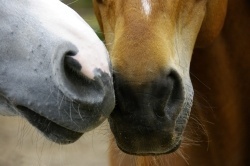
EOTRH - Getting to the Root of the Problem
EOTRH (Equine Odontoclastic Tooth Resorption and Hypercementosis) – a disease which is being increasingly discussed amongst horse owners. But what exactly lies behind this disease? We took a close look at this topic from a medical viewpoint and give helpful tips on how to best feed a horse with this problem.
What causes this extremely painful disease?
As with similar dental diseases seen in humans and felines, the causes for this equine disease remain obscure. The majority of horses suffering from EOTRH are over 15 years old. It is assumed that EOTRH is caused by a heightened mechanical strain on the periodontium in older horses. Unlike in younger horses, the periodontium in older horses is less able to withstand the pressure caused by chewing. This pressure then leads to greater stress to the teeth and the periodontium. This added stress appears to be responsible for inflammatory processes. It is also assumed that the greater stress allows bacteria to enter.What are the visual symptoms of affected horses?
In healthy teeth one finds a balance between the cells that break down dentin (odontoclasts) and those that form it (odontoblasts). In EOTRH this balance is disrupted and the odontoclasts break down this dental substance (resorption) to an excessive degree. Cementum then forms to repair the resulting lesions. However, this formation then continues unstopped, causing the formation of bulbous distensions (hypercementoses), typical of EOTRH, near the roots. These changes primarily affect the incisors, canines and premolars. As mentioned earlier, this disease may involve inflammations in the area of the periodontium. Horses with EOTRH also display inflammatory processes such as swollen or inflamed gums, periodontitis, halitosis and the formation of calculus. In advanced stages, it can also loosen diseased teeth and form abscesses.The stronger the changes are, the more painful this disease will be for the afflicted horse. Horses will often refuse to eat due to the pain, and lose weight.
An EOTRH diagnosis
Before making a suspected diagnosis of EOTRH, the oral cavities will first be clinically examined and typical symptoms noted. This suspected diagnosis is then confirmed through dental X-rays. The severity of the changes can also be determined in the X-ray. Here one often sees a dissolution of tooth substance and a radiopaque mass bulging near the roots.What treatments are available?
In its early stages, shortening of the affected incisors can being pain relief. Severely damaged teeth, however, should be removed to prevent the disease from progressing to healthy teeth. Unfortunately there are not yet treatments that allow damaged teeth to be preserved. Regular rinsing of the mouth and removing residual feed may help to prevent further damage.Annual dental check-ups are also important, even in healthy horses, so that changes to the teeth and gums can be noted and corrections made in good time.
Proper feed management with EOTRH
Especially in loose housing systems it should be noted that horses with tooth diseases my eat roughage much more slowly, resulting in them not getting enough roughage (min. 1.5 kg hay per 100 kg target weight). When kept in groups, older and sick horses are often chased from the feeding stations. These horses should be fed separately so that they can eat sufficient roughage in peace. If the horse has difficulty breaking up hay due to pains and changes to the teeth, the use of hay substitute products such as Pre Alpin® Wiesencobs, Pre Alpin® Wiesenflakes or Pre Alpin® Senior is recommended. These hay substitute products can be fed instead of or in addition to base feed.Affected horses should also be given a high-quality mineral feed such as Naturmineral or Seniormineral. An adequate supply of minerals, trace elements and vitamins is especially important in order to support the healing of the inflamed periodontal tissues. AGROBS Seniormineral is adapted to the needs of older horses and contains essential amino acids for building and maintaining muscle.
Sticky feed components (such as molasses) and high levels of starch and sugar can facilitate tartar deposits. This should be a consideration when feeding horses suffering from EOTRH.
Kraftpaket, Maiscobs and Luzernecobs work well as feed supplements for poor doers. AlpenGrün Mash is a good supplemental feed for horses with delicate metabolisms. AGROBS AlpenGrün Mash can also be given right after dental treatment if the horse’s feed intake is still quite limited. This cereal-free and molasses-free mash also naturally supports your horse’s digestive system. Horse Alpin Senior is a complete feed for horses with dental problems which provides your horse with not only adequate roughage but also with energy and minerals.
To support your horse in the recovery process, we recommend Bergsiegel Herbs for good health or Bergsiegel Rose Hip Powder to boost the immune system.
Dr. med. vet. Katharina Boes
September 2015 ©AGROBS GmbH
September 2015 ©AGROBS GmbH
Sources*:
- Meyer H., Coenen M.: Pferdefütterung. Enke Verlag Stuttgart, 2014
- Carsten V.: Lehrbuch der Zahnheilkunde beim Pferd. Schattauer Verlag, Stuttgart 2011
- Staszyk C. et. al.: Equine odontoclastic tooth resorption and hypercementosis. The Veterinary Journal, 2008
- Schrock, P.: Simulation der Spannungsverteilung im Schneidezahngebiss und in den angrenzenden Kieferregionen des Pferdes. Hannover, Tierärztliche Hochschule, Dissertation, 2013



